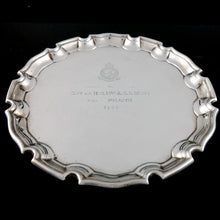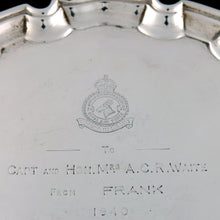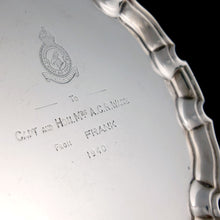Royal Air Force Second World War Presentation Salver, 1939
- Regular price
- £550
- Sale price
- £550
- Regular price
-
- Unit price
- /per
Adding product to your cart
,Diameter: 15cm (6in)
Silver. A George VI salver or waiter with piecrust edge. Engraved with the springbok’s head couped badge of No. 26 Squadron and with presentation inscription ‘To / Capt. and Hon Mrs A.C.R. Waite / from Frank / 1940.’. Maker’s mark of Charles Cooke, Frith Street, London. Hallmarked London 1939.
At the start of the Second World War 26 (Army Co-operation) Squadron was equipped with Westland Lysanders and in October 1939 moved to France. When the Germans invaded Belgium in May 1940, the squadron was forced to move to Kent where it flew reconnaissance, bombing and supply missions over northern France. It was awarded Second World War battle honours for France & Low Countries, 1939-40: Dunkirk: Fortress Europe, 1940-44: Dieppe: France & Germany, 1944-45: Normandy, 1944: Walcheren.
Read more

Colonel Arthur Cyril Roy Waite DL, MC (1894-1991) was an Australian born racing driver and the son-in-law of Sir Herbert Austin, 1st Baron Austin (1886-1941). Born and educated in Adelaide, South Australia, he enlisted in the Australian Imperial Force on the outbreak of the First World War and served with the ANZAC at Gallipoli, and later in France and Flanders. In 1918 he married the daughter of the car manufacturer Herbert Austin whose son and heir was killed in the war. In 1919 Waite joined the Austin Motor Company as the head of development at the firm’s gigantic Birmingham works and in 1923 formed up a works motor racing team in response to a challenge from the Brooklands circuit. After some success at the wheel of a specially prepared Austin Twenty named Black Maria, he formed the first three car Austin Seven racing team in 1925. He made racing history in 1928, winning the first Australian Grand Prix at Philip Island driving an Austin Seven. He also developed the first blown Austin Seven using a three lobed ‘Roots’ type supercharger, and was also responsible for successful twin cam racers of the period. In 1929 he joined the main Austin Board taking control of sales, Service, Publicity and Completion. After crashing whilst driving in the TT race he ceased active racing.








